Tips for Google Chrome users should know
Google Chrome is the most popular web browser today, it provides fast web surfing speed and lots of customization for users to use . The article summarizes tips on Google Chrome that can help users capture and manipulate it according to their wishes in the most effective way.
Trick to use Chrome
- Bookmark (Bookmarks) and toolbars
- Add the Home button to the toolbar
- Show only icons on the Bookmarks bar
- Tab
- Pin a Tab card to the Tab bar
- Open multiple websites when starting Chrome
- Manage multiple Tab easily
- Open a link in the location specified on the Tab bar
- Split a Tab into a new Chrome window
- Address bar (Omnibox) / Search
- Paste and Go / Paste and Search
- Quick search for selected text
- Get fast calculation results from the address bar
- Change the search engine in Omnibox
- Set up personal and synchronous information
- Sync settings with accounts on Google
- Incognito window (Incognito Window)
- Surf the web privately using incognito windows
- Automatically start Chrome in incognito mode
- Privacy
- Clear cookies and browsing history
- Select the data you want to synchronize
- Settings in Chrome
- View and change settings using Chrome URLs
- History
- Clear the history of surfing the Web
- Get a quick list of Web browsing history
- Download and post files
- Remove an item from the Downloads page
- Specify the location to save the downloaded file by default
- Drag and drop downloaded files to another folder
- Other features and extensions
- Chrome Task manager
- Only allow copying and pasting text in Chrome
- Edit any Web page in Chrome
- Set Google Chrome as the default browser
- Shortcuts
Bookmark (Bookmarks) and toolbars
Add the Home button to the toolbar
By default, the Home button is not on the toolbar in Chrome. You just need to click the 3 dash icon on the upper left corner and select Settings . At the Settings page, scroll down to the Appearance section and tick the Show Home button . Now, you can easily go to the homepage with just one click.
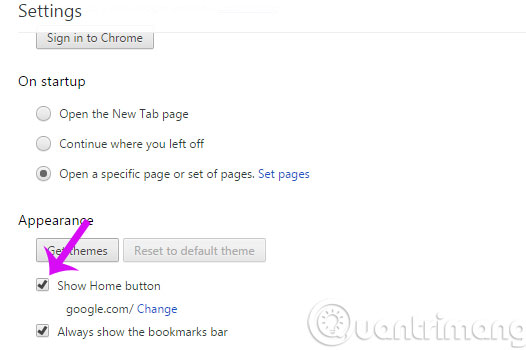
Show only icons on the Bookmarks bar
If you bookmark multiple websites, is it more useful if your favorite pages are displayed in the toolbar as a favorite icon? It's easy to do this. First of all, make sure the Bookmarks bar is always displayed. Click the 3 dash icon, select Settings, and then choose Always show the bookmarks bar in the Appearance section.
Then, right-click on the bookmark page, select Edit. In the new dialog box that opens, delete the text in the Name field. At that time, the bookmark will only contain the icon.
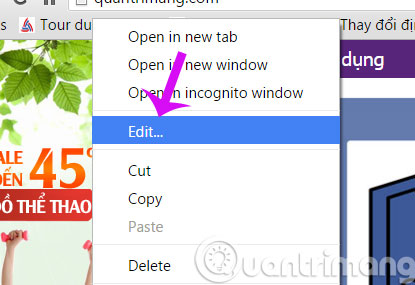
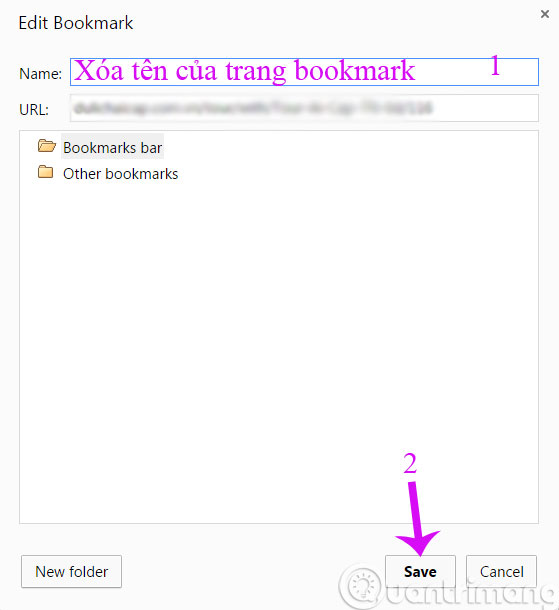
Tab
Pin a Tab card to the Tab bar
There are websites that you can always access whenever you open Chrome. Instead of having to type the website address multiple times, pin these sites to the tab bar permanently, so they'll open automatically every time Chrome is opened. To do this, go to the desired website on a tab, right-click the tab and select Pin tab from the pop-up menu. The tab turns into the website's favorite icon and jumps to the far left of the tab bar.
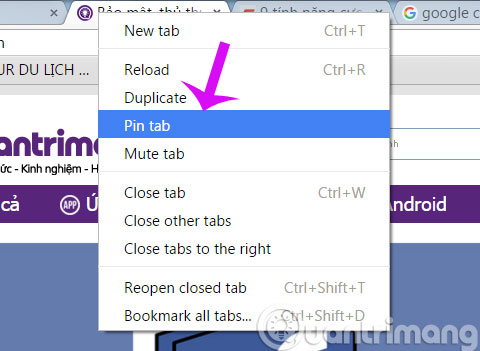
Open multiple websites when starting Chrome
Another way to automatically open visited websites every time you open Chrome is to specify a few URLs in Settings . You also click 3 dashes, select Settings and click the Set pages button in the Open a specific page or set of pages . Add the URL of the website you want in the edit box and press Enter . We can also access each website on separate tabs and then click on Use current pages to quickly add them to the list. Websites are opened on separate tabs, according to the order they are entered when starting Chrome.
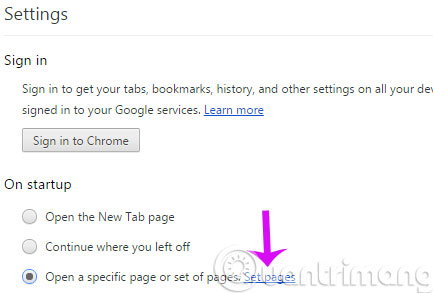
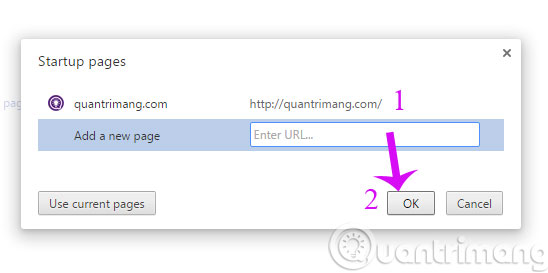
Manage multiple Tab easily
It is easy to manage tabs with the TooManyTabs utility. The utility displays all opened tabs, allows tab searching, TooManyTabs' tabbed display by time of creation, domain or name and restores recently closed tabs. You can also turn off unused tabs to save memory.
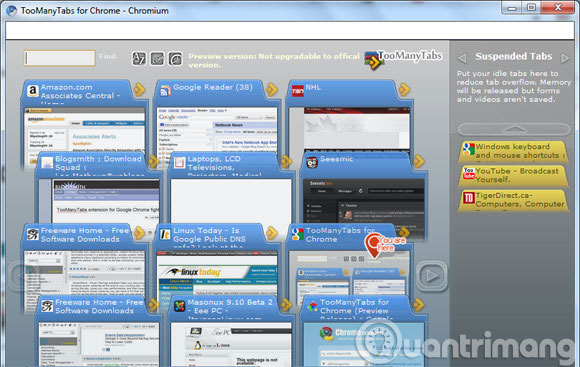
Open a link in the location specified on the Tab bar
When right-clicking on a link and selecting Open link in new tab , the page opens in a new tab next to the current tab. However, you can choose to open the page from the link at a separate location on the tab bar. To do this, hold down the link and drag it to the desired position on the tab bar. A small arrow indicates where the new tab will open.
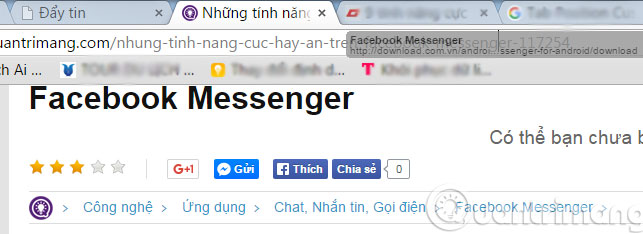
Split a Tab into a new Chrome window
If you want to switch a tab to a new Chrome window, just drag the tab out of the current browser window. The tab is removed from the old window. You can also drag it back to the original Chrome window. If the tab you pull out of a Chrome window is the only tab on this window, the window will close automatically.
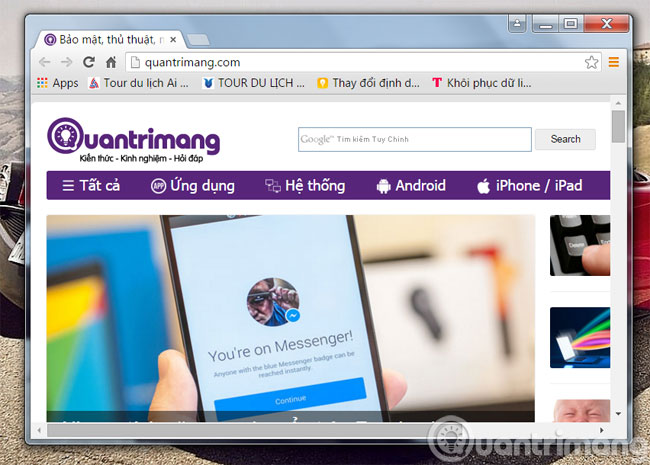
Address bar (Omnibox) / Search
Paste and Go / Paste and Search
If you copy a URL from a program outside Chrome and want to open the website with Chrome, usually you will paste the URL into the Omnibox and press Enter . However, it is faster and more directly accessible by right-clicking on the address bar or Omnibox and selecting Paste and go . If you've copied the text outside Chrome and want to search with Google, right-click Omnibox and select Paste and Search . Google search results will show on the current tab.
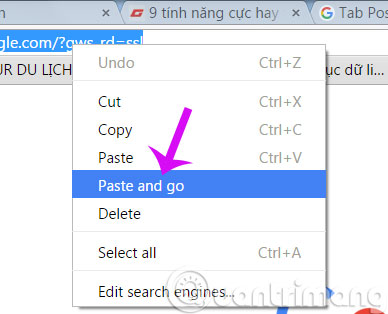
Quick search for selected text
If you have a word or phrase on an unfamiliar website, you can quickly and easily find it on Google. Select a word or phrase, right-click and select Search Google for from the pop-up menu. A new tab opens containing Google search results.
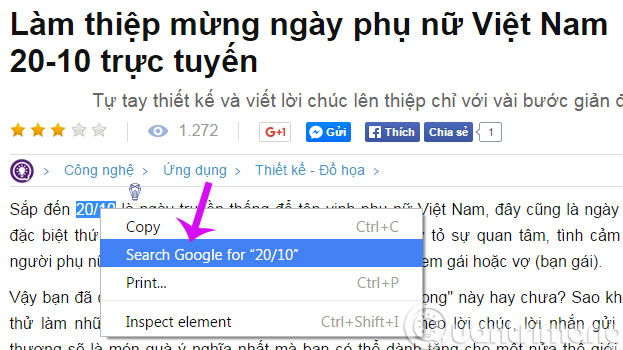
Get fast calculation results from the address bar
Not only can we use Omnibox to search on Google, but we can also use it to perform simple calculations or conversions. For example, type '10 * 10 ' or change ' 2 miles in km ' and wait. Within 1 to 2 seconds, the result will be displayed in the drop down box.
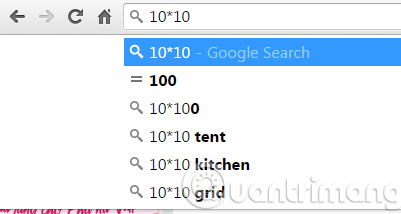
Change the search engine in Omnibox
You can change the default search engine by right-clicking on the Omnibox and selecting Edit search engines from the window that appears. Open settings on a new tab and the Search Engines page appear. The default search engines are listed in the box above. When you use a search box on a separate website, like How To Geek, that website is added as a search engine under other engines. You can also choose to be one of the default search engines or other default engines when using Omnibox to perform searches. Just drag the mouse to the desired search engine and click the Make default button that appears.
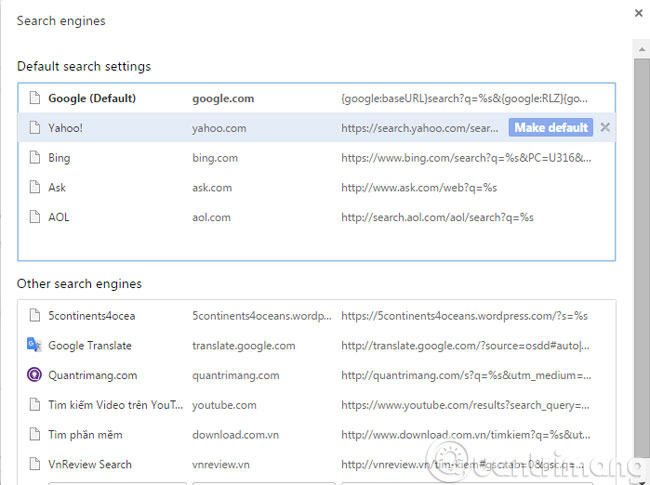
Set up personal and synchronous information
Sync settings with accounts on Google
If you use multiple computers, the synchronization feature in Google can be very helpful. We can sync favorite pages, gadgets, backgrounds and more to our Google account, so the settings will be available in Chrome on any device that is in use. You must be logged into your Google account to be able to sync data in Chrome. Click the 3 dash icon and select Settings . Then enter your Gmail address and password then click Sign in .
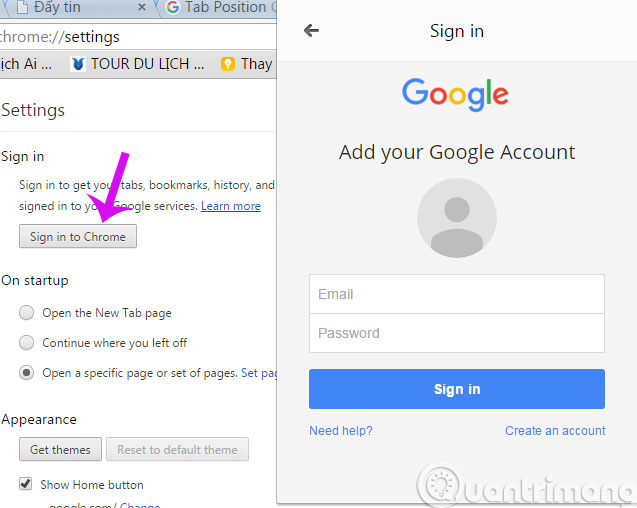
Incognito window (Incognito Window)
Surf the web privately using incognito windows
If you are using the same device with another person or if you are using a public device, you may not want the browsing activity to be recorded. Chrome created a private browsing mode, called Incognito . Any website and file opened and downloaded in incognito mode will not be saved in the browser history and download history. Cookies created in incognito mode are deleted when the incognito window is closed. However, any changes related to settings, bookmarks or edits are still saved.
To open an incognito window, click on the 3 dashes and select New incognito window from the drop-down menu. A special window appeared. Enter the URL in Omnibox to access this page. Browsing and downloading history or cookies from any website accessed in this window will not be saved.

Note: You can press Ctrl + Shift + N to open a new incognito window.
Open a link on a web page in an incognito window by right-clicking on the link and selecting Open link in incognito window from the menu that appears.
Automatically start Chrome in incognito mode
If you regularly use incognito mode, you can set a shortcut icon for Chrome to start Chrome in incognito mode automatically. Please make a copy of the regular Chrome shortcut icon to be able to boot quickly in incognito mode. Right-click the copy and select Properties from the pop-up menu. In the Target box on the Shortcut tab, after the Chrome startup command, highlight it once and then type '-incognito' . Click OK to save the changes. Clicking on this new shortcut will open Chrome in incognito mode.
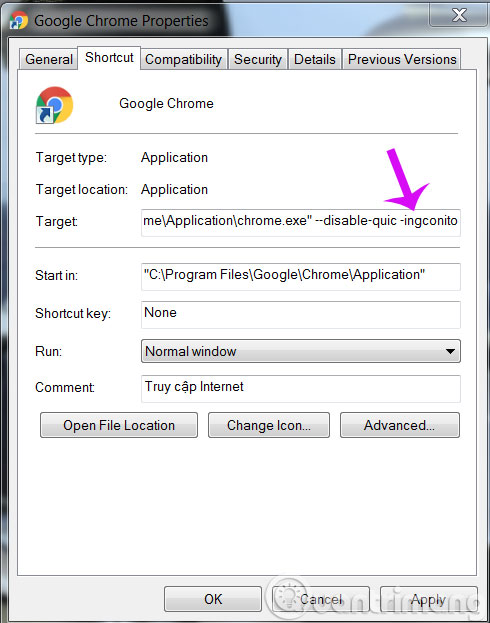
Privacy
Clear cookies and browsing history
Cookies help save a website's login information by saving ID information. Cookies are also used to store shopping information. However, not all cookies are benign. They can also be used to track online activity. Cookie monitoring is a simple job that helps protect personal information. If you do not use incognito mode, and want to delete cookies manually, click on the 3 dashes icon, select Settings . Scroll down to the bottom, then click Show advanced settings . In the Privacy section, click Clear browsing data . A dialog box opens, select the stage where you want to delete items from the drop down list. Once you've selected it, click Clear browsing data .
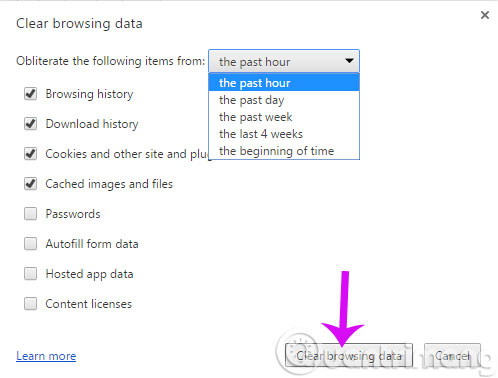
Select the data you want to synchronize
Synchronizing Chrome settings with Google accounts allows us to reuse them on multiple machines. When syncing settings, Omnibox history (everything typed in the address bar, including URLs and search) is synchronized with bookmarks, passwords and extensions. However, if you think about security issues and don't want to synchronize certain data, you can choose the type of data you want or don't want to sync. Click on 3 dashes and select Settings . Next, in Sign in , click Advanced sync settings .
Note: Users must log in to Google to sync settings.
If you want to select the data you don't want to sync, select Choose what to sync from the drop-down list. By default, all settings are selected for synchronization. Uncheck items that do not want to sync. You can also specify that you only want to encrypt password security or encrypt all data. By default, the account password is used as the basis for data encryption. If you want to specify a different password, select the Encrypt all synced data button . and enter the desired password in both boxes that appear. Click OK to accept the change and return to the Settings tab.
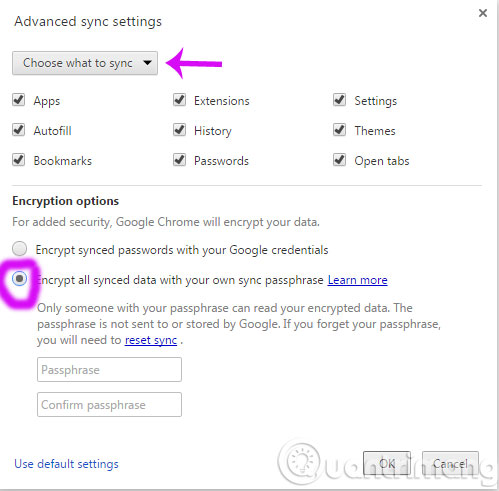
Settings in Chrome
View and change settings using Chrome URLs
You can easily view and change some browser data and settings using special URLs, starting with ' chrome: // '. Enter ' chrome: // about ' to display the entire list of Chrome URLs. These URLs allow you to view browsing history, downloads, favorite pages, utilities and many other hidden features.
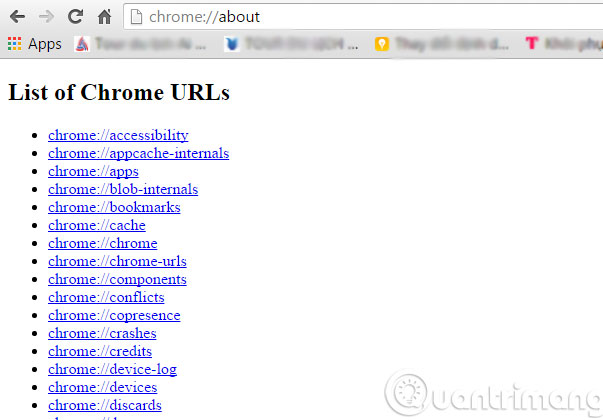
History
Clear the history of surfing the Web
Like any other browser, Chrome follows the websites you visit. This makes it easy to access those websites again using the auto-complete function built into Chrome. However, if you have concerns about privacy or forget to turn on incognito mode, you can still easily delete your browsing history. To enter your browsing history, select History from the menu or press Ctrl + H. Or, enter ' chrome: // history ' in the Omnibox and press Enter . However, there is also an easy way to access history with just one click using the quick button on the toolbar.
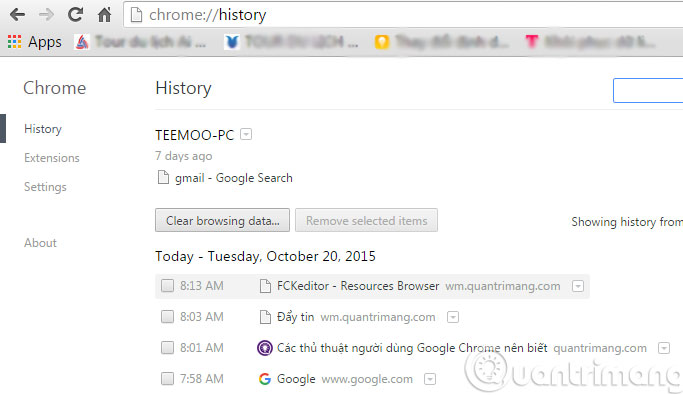
Get a quick list of Web browsing history
To get a quick and quick list of previously visited websites, right-click the Back button or click and hold on it. A short list of recent websites is listed on the drop down menu with a Show Full History option at the bottom of the menu to open the history page.
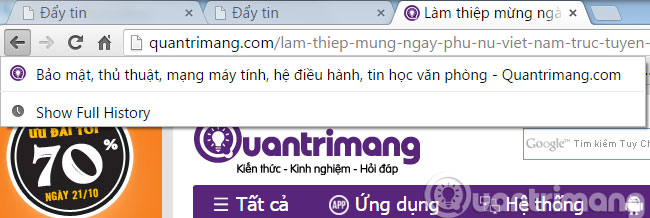
Download and post files
Remove an item from the Downloads page
To access a list of downloaded items, select Download from the menu from 3 dashes or press Ctrl + J. Or, enter ' chrome: // downloads ' in the Omnibox and press Enter . To remove an item from the download list, click Remove under the link.

Specify the location to save the downloaded file by default
By default, Chrome downloads the file to the Downloads folder. If you want to save the file to another location, click 3 dashes and select Settings from the menu. You pull down the Downloads section and click Change on the right of the Download location box.
Instead of the default file location, you can set Chrome to always ask where you want to save the downloaded file by checking the Ask where to save each file before downloading file .
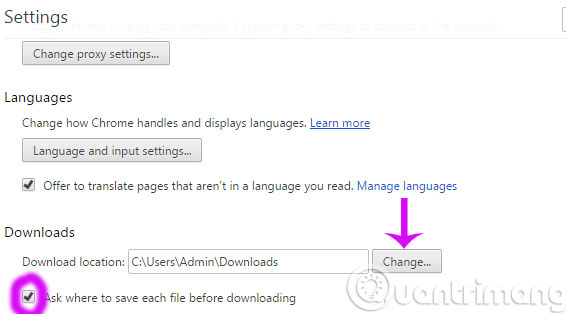
Drag and drop downloaded files to another folder
Once you have downloaded a file, you can easily move it to another location by dragging and dropping it from the Downloads list in Chrome to a folder in Windows Explorer .
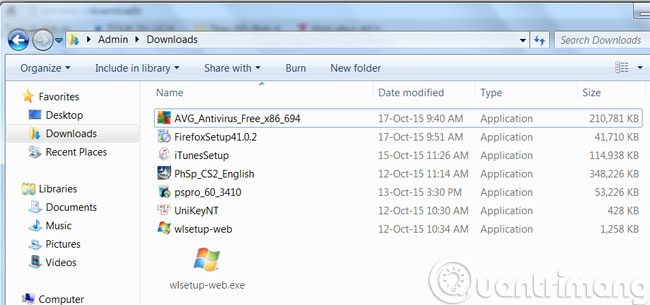
Other features and extensions
Chrome Task manager
Each tab in the Chrome browser is listed as a separate process in Chrome's Task Manager. This allows you to close any tab that is causing you problems without closing Chrome. The Task manager displays open tabs and installed utilities, showing you the memory and CPU resources used by each tab and utility. Access Task Manager by clicking on 3 dashes and selecting More Tools > Task Manager . To close a problem tab or utility, select it in the list and press End process .
Note: You can also right-click the border on the browser window and select Task Manager from the pop-up menu or press Shift + Esc .
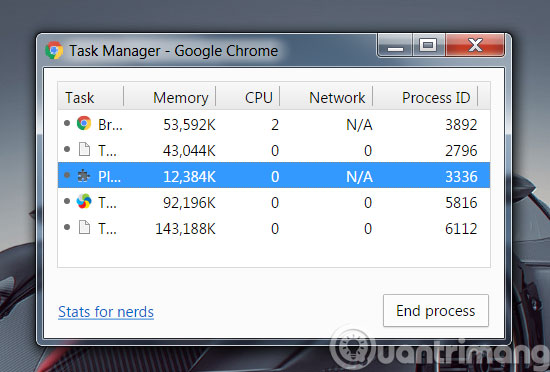
Only allow copying and pasting text in Chrome
In many cases, copying and pasting text into pages in Chrome entails a large amount of unexpected HTML and CSS code or links with copied text. Copy normal text from a web page and when pasting, press Ctrl + Shift + V instead of Ctrl + V. All links, HTML or CSS code will be deleted and only plain text will remain.

Edit any Web page in Chrome
Chrome allows editing web pages directly in the browser. To do this, right-click the site and select Inspect element from the pop-up menu. Edit the HTML source code and press Enter to see the result.
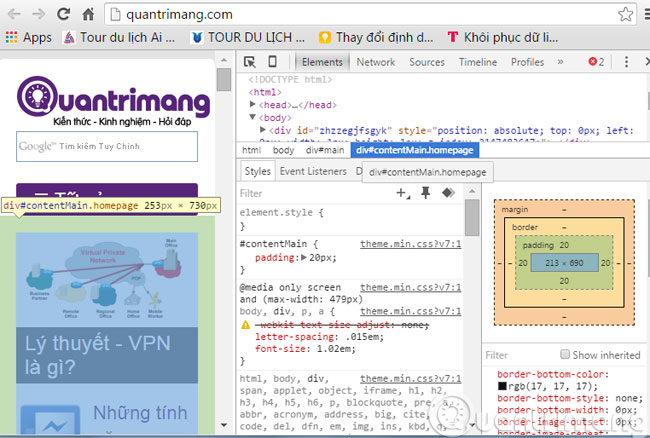
Set Google Chrome as the default browser
When installing Google Chrome, users will be asked if they want to set Chrome as the default browser. If you select No at that time and want to change it again, click 3 dashes, select Settings . Scroll down to find the Default Browse section and click Make Google Chrome the default browser .
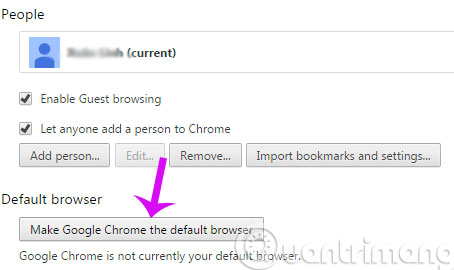
Shortcuts
Here are some shortcuts to using Chrome quickly and efficiently.
- Alt + F - Open the Chrome setup menu
- Ctrl + J - Open the Downloads window
- Ctrl + H - Open the History window
- Ctrl + Tab - Move tabs in order
- Ctrl + 1, Ctrl + 2 . Ctrl + 9 - Jump to different tabs. Ctrl + 9 jump to the last tab.
- Ctrl + T - Open a new tab
- Alt + Home - Open the homepage
- Ctrl + U - View the current page source
- Ctrl + K - Quick search in the address bar
- Ctrl + L - Highlight the URL in the address bar. Use for quick copy and paste
- Ctrl + N - Open a new Chrome window
- Ctrl + Shift + N - Open a new incognito window
- Ctrl + Shift + B - Show / Hide the Bookmarks bar
- Ctrl + Shift + T - Open the closest closed tab. Press Ctrl + Shift + T again to open the closed tab before the nearest tab. Chrome will save the last 10 closed tabs
- Ctrl + W - Close the current tab
- Alt + Left arrow key - Go to the previous page
- Alt + Right arrow key - Go to the next page
- Spacebar - Scroll down the page
All these features and utilities will help enhance your browsing experience on Google Chrome.
- Trick to turn on individual tab off sounds on Chrome
- How to take photos of websites on Chrome and Firefox
- 30 shortcuts for IE, Firefox and Google Chrome
You should read it
- How to delete browsing history on Chrome and Firefox
- 3 Extensions that support managing browsing history in Chrome
- Chrome's incognito mode is not as discreet as you think
- Delete Google Chrome browsing history on Windows and Mac
- How to save web browsing history when browsing in incognito mode on Chrome browser
- How to delete search browsing history in Google Chrome?
 Users can turn off tab sounds on Chrome
Users can turn off tab sounds on Chrome How does Google Chrome run faster?
How does Google Chrome run faster? Attractive extensions on Google Chrome
Attractive extensions on Google Chrome Will Chrome's 'Throne' in Vietnam be deposed?
Will Chrome's 'Throne' in Vietnam be deposed? Fix IDM errors automatically download music on browsers
Fix IDM errors automatically download music on browsers Opera Mini launches the official version for Windows Phone
Opera Mini launches the official version for Windows Phone